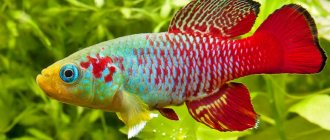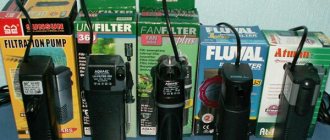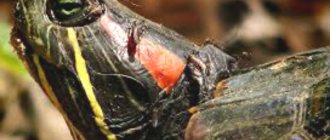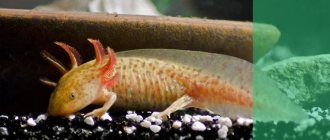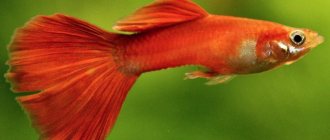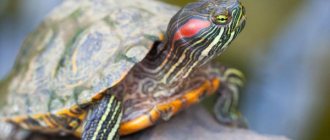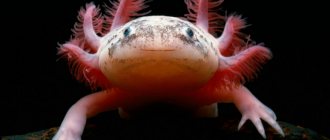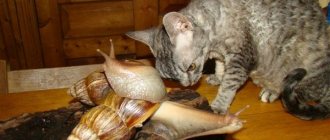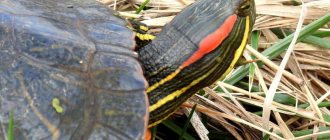Aquarium shrimp belong to the family of crustaceans, which are characterized by enormous endurance and adaptability.
Instead of claws, shrimp have three pairs of jaw legs, which are responsible for movement, long antennae and a powerful tail. The shrimp's body is covered with chitin. Shrimp are excellent at navigating in an aquarium due to their ability to rotate their eyes.
Aquarium shrimp are kept in special freshwater aquariums with clean and well-settled water, since shrimp are very sensitive to any chemical composition of water.
The main types of shrimp for home breeding in an aquarium
Often, freshwater species, which are compact in size, are chosen for the home. All varieties differ in shades and colors. The best types will be discussed in more detail below.
Neocaridins
- This type is suitable for those who are just starting to breed shrimp at home. You can buy wild varieties or derivatives that were bred from them.
- The most common neocaridins are cherry or cherry.
Subspecies
In addition, you can place in the aquarium:
- "White Snowflake";
- "Canary";
- "Blue Pearl";
- "Orange sakura."
Classic representatives of this species are almost colorless. However, after some time, individuals can be painted in other shades, including scarlet, lemon, blue and green. It depends on the quality of the soil, lighting and diet.
- The richer the shade of the soil, the brighter the color of the individuals. On average, neocaridins grow to 2-3 cm in length.
- Therefore, large fish that will feed on shrimp should be excluded from the aquarium.
Amano
- This variety is also easy to care for. It constantly destroys algae that grows in the aquarium. If you plan to breed Amano, fill the container with unusual water. The best option would be salt water, in which the caviar matures.
- The shade of individuals depends on the diet. If plant foods predominate, the shrimp will be light green. Otherwise they will be scarlet. In the upper part of the body there is a stripe of a golden hue.
- Spots and streaks may also be present If there are spots, it means that this is a male. The strokes indicate the female. Females grow up to 7 cm, and males - up to 3.5 cm.
Macrobrachium
- The peculiarity of this species is that its representatives can live even in hard water. Moreover, they belong to the category of predators and can attack other residents of the aquarium.
- The body length is 25 cm . The color can be different: blue, black or yellow.
Babaulty
- Prefers to be in fresh water. This type is compact. Individuals grow up to 4 cm. The color can be different: brown, green, red, blue and orange.
- The front part of the shell is curved down. There is a longitudinal stripe on the back. On average, individuals live 5 years.
Greenfinch
Cardinal
- The shade of the individuals is quite attractive - scarlet in all its manifestations. snow-white spots throughout the body that create additional contrast. Sometimes the white dots have a blue edge.
- The limbs are red, with the exception of the forelimbs, which are white. The maximum body length is 2 cm. On average, this species lives no more than a year.
What to feed
As a rule, there are no problems with feeding shrimp. The undoubted advantage of this crustacean animal is its omnivorous nature. In its natural habitat, the shrimp's food includes moss, algae, plant leaves, small fish, and sometimes even its own shell.
But there is another serious problem caused by cannibalism. These representatives of the crustacean families (although not all, but only some subspecies), with a lack of nutrition or overcrowding of the reservoir, may well eat their own kind. It is in order to avoid such adverse consequences that it is recommended to use spacious tanks or artificial reservoirs for breeding, as well as to provide the shrimp with a sufficient number of reliable shelters.
A properly balanced diet will help prevent cannibalism and accelerate the growth and development of shrimp. Experts recommend including both dry granulated food and live food (for example, Artemia larvae) in the daily menu. This option (a combination of live and ready-made food) allows you to diversify the diet and provide the shrimp with all the nutrients and elements they need. Of course, preference is always given to live food, but using only one will be extremely expensive for the shrimp owner.
You can prepare high-quality dry food yourself at home. To do this, simply combine in equal proportions such components as plankton, egg powder, crushed algae, milk powder, fish oil, and fortified supplements. The resulting mixture is dried and then ground to a powder. This food has a high nutritional value, a high content of protein and vitamins, and can also be stored for a long time, which is extremely convenient.
Considering the omnivorous nature of shrimp, they will always be able to find additional food for themselves by consuming algae, leaf plates of underwater and surface crops. Such nutrition will be very useful for pets, so it is important to decorate the aquarium with plants and provide sufficient lighting for their active growth.
It is recommended to feed shrimp once every 2-3 days to avoid overfeeding and obesity, disruption of deceptive processes and other diseases.
During the breeding or molting period, the animal's need for protein and other nutrients will especially increase, so the shrimp are transferred to daily feeding, offering food 1-2 times during the day.
An interesting feature, characteristic exclusively of shrimp, is that for quite a long time they can do without food at all, feeding on organic microparticles that are invariably present in any artificial reservoir. This is a very valuable quality that allows the owner of shrimp to go away for several days or even 2 weeks without fear for the condition of their pets.
How do shrimp behave in an aquarium?
- If you are just planning to breed shrimp at home in an aquarium, first study the peculiarities of their behavior. They are often quite active . They prefer to move along the bottom and algae that grow in the aquarium. Sometimes individuals swim in the water. Swims in groups are carried out during the “walking” of females. They release pheromones into the water that attract males.
- If you change the water, there is strong activity of individuals . At the moment of adding water, the shrimp think that it has started to rain. Therefore, they will rise up and practically “fly” around the container. This is a completely normal occurrence and there is nothing to be afraid of. If other fish live in the aquarium together with shrimp, you need to be wary. After all, many fish consider crustaceans to be food.
- If the behavior of individuals is strange, this may indicate the presence of diseases or water pollution.
Shrimp are usually active.
If you have not changed the water for a long time or have exceeded the permissible number of shrimp per available volume, dangerous impurities will appear, including:
- ammonia substances;
- nitrites - no more than 0.2 mg per 1 liter of water is permissible;
- nitrates - the permissible amount is no more than 80-100 mg per 1 liter.
If the crustaceans are immobile, there is a high probability that they have been poisoned. Therefore, you need to take action immediately. First, replace 25% of the water with clean water. If you notice your shrimp molting, don't panic. This is quite normal. The formed skin cannot be removed. The shrimp will eat it.
Features of choosing an aquarium for shrimp
- As already mentioned, shrimp do not require special care. Therefore, there are no clear requirements for choosing an aquarium. Preference should be given to wide and low containers with a volume of 10 liters or more. Considering that shrimp prefer to walk along the bottom, it is better if its area is large.
- If you breed neocaridins and other compact specimens, the aquarium should be designed for 30 liters. Large individuals should be kept in larger containers. If you provide optimal conditions for shrimp, this will speed up the reproduction process. Therefore, it is better to buy larger options in advance so that all individuals fit into them.
Reviews
The health of arthropods depends on the conditions created. The more the aquarist takes care of his pets, the longer they will live in the aquarium.
Was this information useful to you? Share in the comments!
Necessary equipment for a shrimp aquarium
- In addition to the main container for shrimp, you will need to buy a special filter. You can find it in your nearest pet stores. Choose models in which the filter material is made of sponge. They are more budget-friendly, so they are ideal for beginners. At the same time, they are easy to clean.
- If the filters do not have sponge material on them, they cannot be used. After all, the shrimp will be sucked inside and die.
- You should also buy a lamp , a water heater and a thermometer. There are aquariums on sale that already have a built-in light on the lid. However, you can also buy individual devices whose spectrum is “warm” or “white” light. This will contribute to a more saturated color of the shrimp. Make sure there is at least 7 hours of daylight per day.
- Buy thermometers and heaters that are small. This will help maintain the optimal water temperature. Otherwise, the shrimp will not reproduce and will die. You should also buy gravel .
- Fractions should be from 2 to 5 mm. Ordinary sand, the fraction of which is about 1 mm, is also suitable. Don't forget to buy special primer for shrimp. Such devices are available in the nearest pet stores.
Provide your aquarium with everything you need
Diseases
Shrimp diseases most often appear as a result of improper nutrition. Among the frequently encountered ones, it is necessary to highlight:
- Picornavir infection - the disease is manifested by slow movement of the individual and floating upside down. The infection cannot be treated, so it is necessary to promptly eliminate infected specimens;
- glowing disease – fry and eggs are susceptible to this type of disease. The first symptoms are lethargic behavior, lack of appetite, and the appearance of white stripes on the sides. To treat the disease, it is necessary to change the water and thoroughly disinfect the container;
- Vibriosis is a shrimp disease that appears as red spots on the shell. If left untreated, the body of the individual begins to rot. To eliminate symptoms, it is recommended to use antibiotics;
- black gills - manifests itself in the form of blockage of the gills. Oxygen does not enter the body, resulting in suffocation. Upon careful examination, you can see a black coating in the gill area. This type of disease has no cure.
To ensure that aquatic inhabitants are not exposed to diseases, it is necessary to promptly change the water and monitor their diet.
When to add shrimp to the aquarium?
- First you need to prepare the aquarium. It is washed in tap water. The main thing is not to use substances that contain chemicals. Pour gravel inside and pour in water. It needs to be prepared first. Using a special conditioner, remove chlorine, chloramine and other harmful substances from it. Immediately install the filter and run it. If the water becomes cloudy at first, don’t worry. After some time it will become transparent again. Then put in a thermometer.
- Within 24 hours the water will reach +30°C. Then start planting the plants. Plant varieties with long stems at the back. Plants with rosettes should be in the middle, and compact species should be in the foreground. If you plant moss, place it near glass. Remember that moss is an important detail. After all, shrimp use it for shelter and food.
- After a day, add crustaceans. To begin with, they acclimatize . To do this, place the shrimp in a bag and lower it into aquarium water for 2-3 hours. Then you can put them into the container. After 7 days, the first water change is carried out (about 15% of the total volume). After this, this process should be carried out every week. Clean the soil several times a month using a siphon.
- After 20 days, you need to test the water for nitrates, acidity, nitrites and ammonia. Special tests are purchased at pet stores. The normal pH level is 6-7.5. There should be no nitrites or nitrates in the water at all.
Recommended water values:
- neutral or alkaline (from 6.8 to 8.5 pH);
- hardness – from 6 to 25;
- temperature – from +15°С to +30°С.
Compatibility of shrimp in an aquarium with other species
- Shrimp belong to the category of bottom shrimp. It is not prohibited to populate them with fish. The exception is large and carnivorous fish, since predators will eat crustaceans.
- Compatibility must be determined by the size of the container, water parameters and the number of algae. If you are in doubt about your choice, you can consult with a pet store employee or experienced aquarists. The best neighbors for shrimp in an aquarium are fish that eat plants (neons, rainbows, guppies, microrasboras and tetras).
- It is better to exclude fish such as gourami, swordtails, angelfish, discus, cichlids, catfish and goldfish from the aquarium into which shrimp are added. If you place several types of shrimp in one container in order to further increase their number, it is better not to add fish to the aquarium at all.
Shrimp are compatible with many fish
general description
Although there are many types of aquarium shrimp, they all have one thing in common - the same body structure. They have a well-developed tail, eyes with a wide viewing angle, and long mustaches that perform the function of touch. Instead of claws, they have three pairs of jaws that perform a motor function. The entire body is covered with a layer of chitin. In addition, females are usually almost one and a half times larger than males.
In all other respects, these arthropods are not similar to each other. They differ in origin and belonging to a particular family, in size, color and habitat. Therefore, there are several types of aquarium shrimp. Some do not require special care, while others can only be kept by an experienced breeder.
Nutritional Features
- If you plant algae , the shrimp will never experience hunger. In addition, try to buy food that contains chitin. This will ensure normal shedding. You should add food to the shrimp diet no more than twice a week. Be prepared that the process of water pollution will accelerate. Therefore, it will be necessary to change the water more often, as well as siphon the soil.
- Shrimp prefer to eat pumpkin, carrots, oak leaves, zucchini, cucumbers and almond leaves. Make sure you don't overeat the shrimp. The crustaceans must eat everything within an hour. Remove any leftovers immediately to prevent the water from spoiling.
- There are ready-made food options for shrimp on sale. They may come in the form of powder or granules. They contain everything necessary for crustaceans. They do not spoil the quality of water, and also help improve the color of individuals. If you put shrimp in hard water, special food will be necessary. In addition, it will speed up the process of spawn recruitment and reproduction.
A varied diet is important
- If you bought expensive varieties of shrimp, you need to feed them with nutritious Japanese food. This is the best option for caridine, black and red crystals. Shrimp are not averse to eating unripe nettles. To do this, you need to pick leaves from bushes that grow in places with a clean environment. It is better to do this in April or May.
- Give preference to leaves that form at the tops. Afterwards they need to be poured with boiling water for a quarter of an hour. This will remove bacteria and soften the nettles so they are easier for the shrimp to eat. However, nettles should not be used as the basis of the diet. It can be given as a treat.
- You need to feed the shrimp once a day. Some aquarists believe that it is better to do this every other day. It is recommended to do 1 day a week as a fasting day. Remember that overfeeding is one of the main causes of death in shrimp.
Features of shrimp reproduction in an aquarium
In order to propagate shrimp in an aquarium at home, several conditions must be met:
- high-quality water that meets all requirements;
- stability;
- regular feeding with food containing chitin;
- the presence of males and females in one container.
Reproduction begins when individuals grow to 1 cm in length. Neocardines are ready to mate when a bright yellow spot appears on their back. This is an indicator of the presence of eggs that need fertilization. Afterwards the eggs are incubated for a month. After this time, young individuals will appear.
Causes of death of shrimp in an aquarium
Very often, aquarists are faced with the death of shrimp. This can happen for various reasons. They will be discussed in more detail below.
Water pollution
- If chlorine and chloramine are formed in the water, the shrimp will die. Some people advise letting the water sit to allow the chlorine to dissipate.
- The peculiarity of chloramine is that it is almost impossible to remove it. Therefore, you will have to use dechlorinators. Chloramine can accumulate in water, which will soon lead to the death of crustaceans.
Presence of ammonia or nitrites
- If the amount of these substances in the aquarium is exceeded, the shrimp will die. It should be noted that they are often located at the bottom.
- This is where their waste accumulates.
Low acidity
- If you pour tap or distilled water into the container, this can cause the pH level to drop sharply. If it is below 6, the shrimp will stop being active.
- It is better to carry out tests regularly to determine the pH level. This way you will know when to raise it. Some sources contain information that increasing pH can be done using baking soda. However, this is not the best idea, since sharp jumps will provoke the death of crustaceans.
- It is better to give preference to stones (shell or crushed coral). They will raise the pH level gradually.
Keep your shrimp healthy
Avoiding Mistakes
You need to carefully monitor the hardness and acidity of the water. These parameters are extremely important for maintaining the life of these crustaceans. The water temperature must also be maintained. To control it, you should install a thermometer in the aquarium. It is recommended to use an aerator to saturate the water with oxygen.
Previous
CrustaceansAquarium crabs are bright loners with a funny character
Next
CrustaceansTop 9 crabs you want in your aquarium
How to save sick shrimp in an aquarium?
- If you notice that your shrimp are less active, it means they have health problems. They need to be moved to a separate container filled with clean and settled water. You can also take tap water and purify it with conditioner. In just a few days, the individuals will return to normal, and they can be moved to a general aquarium.
- To clean the container in which sick individuals were located, clean the soil using a siphon . Then change the water (about 1/3 of the total volume). The filter needs to be washed.
Now you know under what conditions aquarium shrimp should be kept. As you can see, there is nothing complicated. It is important to keep the container clean, as well as monitor diet and water quality.
Useful articles on the site:
- Does fish like valerian?
- How to properly care for pet fish
- Tilapia fish
- Which sea fish is the healthiest?
- Fish without bones or scales
